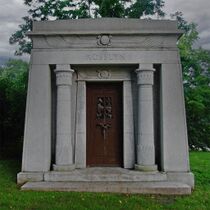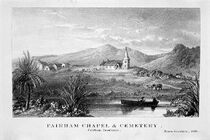Fairham Cemetery and Crematory: Difference between revisions
No edit summary |
(kill!) |
||
| (One intermediate revision by the same user not shown) | |||
| Line 9: | Line 9: | ||
| map_caption = | | map_caption = | ||
| established = {{start date and age|1876|09|17}} | | established = {{start date and age|1876|09|17}} | ||
| location = [[Fairham, Henria|Fairham]], [[ | | location = [[Fairham, Henria|Fairham]], [[Cabot]], [[Henria]] | ||
| country = [[Insulamia]] | | country = [[Insulamia]] | ||
| coordinates = | | coordinates = | ||
| Line 17: | Line 17: | ||
| graves = | | graves = | ||
| cremations = | | cremations = | ||
| website = {{url|https://www.nationstates.net/insulamia|fairhamcemetery.org | | website = {{url|https://www.nationstates.net/insulamia|fairhamcemetery.org}} | ||
}} | }} | ||
'''Fairham Cemetery and Crematory''', formerly '''Fairham Chapel and Cemetery''', '''Fairham Anglican Cemetery''', and '''Fairham Anglican Cemetery and Crematory''', is a {{wp|cemetery}} and {{wp|Crematorium|crematory}} in [[Fairham, Henria|Fairham]], a district of [[ | '''Fairham Cemetery and Crematory''', formerly '''Fairham Chapel and Cemetery''', '''Fairham Anglican Cemetery''', and '''Fairham Anglican Cemetery and Crematory''', is a {{wp|cemetery}} and {{wp|Crematorium|crematory}} in [[Fairham, Henria|Fairham]], a district of [[Cabot]], [[Insulamia]]. The cemetery opened in 1876, whilst the crematory opened in 1938. Prior to 1945, it served only {{wp|Anglican}} burials, but since then it has been catering to many more religious and cultural requirements. | ||
==History== | ==History== | ||
| Line 27: | Line 27: | ||
===Second World War=== | ===Second World War=== | ||
After the conclusion of the {{wp|World War II|Second World War}}, the cemetery built a war memorial, next to which around 100 fallen soldiers were buried. Catholic families and those of other {{wp|Christian denomination|Christian denominations}} requested for their soldiers to be buried in the cemetery – which was Anglican-only at the time – and the Fairham Cemetery Trust obliged. | After the conclusion of the {{wp|World War II|Second World War}}, the cemetery built a war memorial, next to which around 100 fallen soldiers were buried. Catholic families and those of other {{wp|Christian denomination|Christian denominations}} requested for their soldiers to be buried in the cemetery – which was Anglican-only at the time – and the Fairham Cemetery Trust obliged. | ||
===Cabot Killer message=== | |||
{{main|Cabot Killer#Mausoleum of Amadeus Rosslyn}} | |||
[[File:Rosslyn Mausoleum.jpg|thumb|upright=0.7|alt=Photograph of a stone mausoleum with the word "ROSSLYN" engraved on its top|{{wp|Egyptian revival}} mausoleum of Amadeus Rosslyn]] | |||
On 16 July 1973, cemetery staff discovered a carving on the back of the {{wp|mausoleum}} of [[Amadeus Rosslyn]] in the cemetery and reported to police. It read: | |||
{{blockquote|29·6·1973<br/>19·7·1973<br/>1·12·1973<br/>LILVLSLLLVEAVIITSESOV<br/>·CABOT·}} | |||
Investigators confirmed that this was a message from the [[Cabot Killer]], a {{wp|serial killer}} who would go on to murder [[Victims of the Cabot Killer|thirteen people]] in [[Cabot]] between 1972 and 1980, and who left multiple cryptic writings across the city. It is commonly believed that the that the first three lines are dates – the first being the date it was carved, the second forecasting the date of the [[murder of Genevieve Adams]], and the third forecasting the date of another message. However, no messages dated 1 December 1973 have been found to this day. The last line is the signature of the killer, found in all other messages. The fourth line is presumed to be a kind of {{wp|substitution cipher}}, though its {{wp|Key (cryptography)|key}} and hence its {{wp|plaintext}} remains unknown. | |||
It is not believed that the Cabot Killer had any personal connection to Fairham Cemetery and Crematory. After the message was found, police immediately analysed it forensically but to no avail. The cemetery reportedly increased their security measures following the incident. | |||
==Notable interments== | ==Notable interments== | ||
* [[Percival Mason]] – zoologist | * [[Percival Mason]] – zoologist | ||
* Lord [[Amadeus Rosslyn]] {{wp|Fellow of the Royal Society|FRS}} – Egyptologist, proprietor | * Lord [[Amadeus Rosslyn]] {{wp|Fellow of the Royal Society|FRS}} – Egyptologist, proprietor | ||
Latest revision as of 04:22, 20 June 2023
 Grave of John Walker, founder of the cemetery, and his family | |
| Details | |
|---|---|
| Established | September 17, 1876 |
| Location | |
| Country | Insulamia |
| Type | Public |
| Owned by | Fairham Cemetery Trust |
| Size | 10 hectares (25 acres) |
| Website | fairhamcemetery.org |
Fairham Cemetery and Crematory, formerly Fairham Chapel and Cemetery, Fairham Anglican Cemetery, and Fairham Anglican Cemetery and Crematory, is a cemetery and crematory in Fairham, a district of Cabot, Insulamia. The cemetery opened in 1876, whilst the crematory opened in 1938. Prior to 1945, it served only Anglican burials, but since then it has been catering to many more religious and cultural requirements.
History
In 1876, Anglican Canon John Walker built a chapel and a cemetery for the community of Fairham, and it was named Fairham Chapel and Cemetery. Walker was buried in the cemetery upon his death in 1890, requesting a "modest burial". After his death, the ownership of the cemetery was transferred to a trust that Walker had helped to set up before his death – the Fairham Cemetery Trust. They changed the name of the cemetery to Fairham Anglican Cemetery in 1905. The crematory was built from 1937 to 1938, and first cremation was of Martha Donaldson on 8 March 1938. The name changed to Fairham Anglican Cemetery and Crematory to reflect the addition. In 1945, the cemetery started holding Catholic ceremonies and thus removed the word Anglican from its name. Since, it has been open to many kinds of burials, including Lutheran, Eastern Orthodox, Jewish, and irreligious.
Second World War
After the conclusion of the Second World War, the cemetery built a war memorial, next to which around 100 fallen soldiers were buried. Catholic families and those of other Christian denominations requested for their soldiers to be buried in the cemetery – which was Anglican-only at the time – and the Fairham Cemetery Trust obliged.
Cabot Killer message

On 16 July 1973, cemetery staff discovered a carving on the back of the mausoleum of Amadeus Rosslyn in the cemetery and reported to police. It read:
29·6·1973
19·7·1973
1·12·1973
LILVLSLLLVEAVIITSESOV
·CABOT·
Investigators confirmed that this was a message from the Cabot Killer, a serial killer who would go on to murder thirteen people in Cabot between 1972 and 1980, and who left multiple cryptic writings across the city. It is commonly believed that the that the first three lines are dates – the first being the date it was carved, the second forecasting the date of the murder of Genevieve Adams, and the third forecasting the date of another message. However, no messages dated 1 December 1973 have been found to this day. The last line is the signature of the killer, found in all other messages. The fourth line is presumed to be a kind of substitution cipher, though its key and hence its plaintext remains unknown.
It is not believed that the Cabot Killer had any personal connection to Fairham Cemetery and Crematory. After the message was found, police immediately analysed it forensically but to no avail. The cemetery reportedly increased their security measures following the incident.
Notable interments
- Percival Mason – zoologist
- Lord Amadeus Rosslyn FRS – Egyptologist, proprietor
- Alexander Wright-Poussey – ship captain
- Teddy Collingwood – proprietor
- Edith Collingwood – author and wife of Teddy Collingwood
- Major General Henry Real
- Richard Fairham – priest
- Donna Cameron – actor and entertainer
- Sir Frederick Fairham – World War II pilot, Order of Insulamia recipient
- Admiral John Kingsley
- Eleanor Jackson – activist during the 1972 Springtime
- Caroline le Nouvillais – first female member of the House of Representatives
- Ralph Smith – computer engineer, artist
- Melody Finchley – comedian
In media
Fairham Cemetery and Crematory is mentioned as the burial place of the character Jimmy Woolworth in season 3 episode 10 of the crime television series The Monopolist of Violence.
